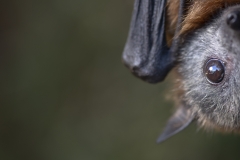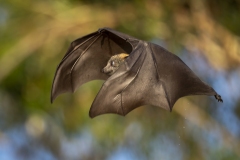Melbourne’s flying night gardeners
SOME FACTS
Conservation status:
The Grey-headed Flying-fox (GHFF)is considered to be a single, mobile population with individuals distributed across Queensland, New South Wales, Victoria, South Australia, Tasmania and the ACT. Accepted population estimates sit somewhere between 320,000 to 435,000, representing a 90%+ reduction since British colonisation. With continued population decline (and with low population growth rates even if optimal conditions existed), this species is listed as:
i) ‘Vulnerable’ under the IUCN red list,
ii) ‘Vulnerable’ under the Australian Commonwealth Environment Protection and Biodiversity Conservation Act (1999) and
iii) ‘Threatened’ under the Victorian Flora and Fauna Guarantee Act 1988
In Melbourne in summer, you may see up to 50,000 flying out at night for dinner (well technically breakfast for them)
Key threats:
– Extended habitat destruction and degradation of foraging and roosting over extended areas
– Conflict with people, including deliberate camp disturbance
– Heat stress events
– Entanglement in back yard fruit-tree netting
– Entanglement in barbed wire
– Electrocution in power lines
Most don’t know:
Most people are generally unaware that:
– Bats have specialised tendons in their feet that enable them to hang whist being perfectly relaxed. Indeed hanging upside down takes less effort.
– GHFFs are vegetarian
– GHFFs are highly intelligent, social, and caring mammals that breast feed their young
– GHFFs are a vital ‘keystone’ species – meaning that many other species (both plants and animals) rely upon them for their survival and well being
– GHFFs are vulnerable/threatened to significant population decline
– GHFFs are regularly maimed and killed by the largely preventable impacts of inappropriate back yard fruit tree netting and barbed wire
– A significant amount of work goes into rescuing and caring for GHFFs caught in nets/barbed wire
– In Melbourne, during summer at dusk, they create one of nature’s great spectacles – 50,000 flying mammals heading out over a major city at night, looking for dinner!
– The scientific name, Pteropus poliocephalus, translates to “wing foot grey head” from Pteron= wing, pous = foot, polios=grey, cephalus = head
How can you help?
1. Welcome them
– If you have Grey-headed Flying-fox’s in your neighbourhood or garden, you’re so lucky to have them.
2. Plant flowering gums and nectar bearing native trees and shrubs
– Fruit bats love flowering gums and nectar-bearing trees so if you can, plant some.
3. Use only wildlife-friendly fruit-tree netting
– Ideally fruit tree netting should not be used at all. If you feel you must, this means any netting should have a gap size of less than five millimetres. If you can put your little finger through it, it is too big. Also avoid using black and/or monofilament types.
– When attaching it, also ensure that all of the netting is taut. They are less likely to get caught if spread tightly over a frame rather than thrown loosely over a tree
4. Manage any barbed wire
– Avoid using barbed wire if you can. It can maim and kill many species, not just bats.
– If you must use barbed wire, paint the top fluoro or white. This allows wildlife to seeit at night and helps avoid entanglement. Also consider covering any wire with bags or plastic pipes near trees where GHFF’s may feed. If you have barbed wire that no longer has any purpose, get it removed.
5. Do not disturb
– If you are visiting a colony or camp, or you’re lucky to find a bat or two enjoying a meal of fruit or nectar somewhere, keep noise to a minimum, keep your distance and keep pets away.
6.Protect the homes they have
– They are already running out of space and places to live and eat, so reject any ‘development’ or ‘works’ that encroaches on or disturbs their homes (i.e. established colonies or camp sites) or impacts our forests.
7. Protect native forests
– They need native forests for food. They also act as ‘stepping-stones’ in their migration up the coast.
8. Don’t fish around flying-fox colonies and remove old fishing lines and hooks
– As flying-foxes dip into the water to cool off and grab a drink, they can also get entangled in old fishing lines and hooks. If you find any in waterways, safely dispose of them.
9. Support a local animal rescue organisation
– Thousand of hours and thousands of dollars are spent by selfless volunteers rescuing and caring for bats each year. Even a few dollars makes a big difference, so consider supporting animal and bat rescue groups in your local area. Join a volunteer or community group that supports wildlife and native forest conservation.
11. Get help immediately if you find an injured GHFF
– A bat found alone during daylight hours is most likely in trouble. If you see one in fruit tree netting, on power lines or on barbed wire, it is definitely in trouble and in need of urgent care. The longer they are trapped, the more damage they will do to themselves and the more stress they are under.
In breading season (late September-December) keep an eye out for possible babies on electrocuted flying foxes on power lines. Sometimes the mother will be dead but the baby is still alive.
N.B. Never touch a bat if you find one. Immediately call your local wildlife group for assistance.




















